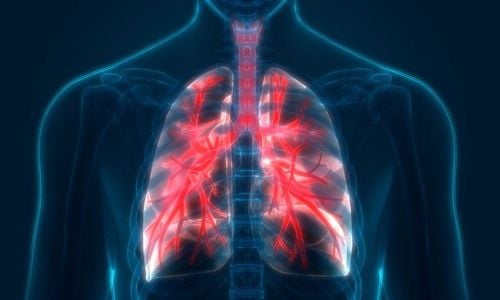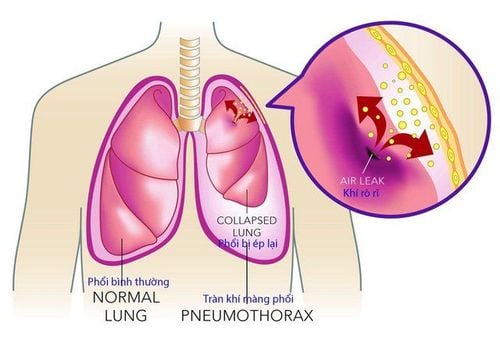This is an automatically translated article.
The article was professionally consulted by Dr. Nguyen Van Dinh - Head of Respiratory - Asthma - Allergy - Clinical Immunology Unit, Vinmec Times City International Hospital.Asthma is a common chronic respiratory disease in the population with symptoms of cough, wheezing, shortness of breath and chest tightness. If asthma control is not effective, long-term asthma will cause various complications, impair health, and affect the patient's quality of life.
1. Chest deformity
The typical feature of bronchial asthma is obstruction of the airways during expiration. Pathogenesis is usually due to the interaction between the organism and environmental factors. Accordingly, this disease often manifests very early, from a young age. Long-term obstruction not only makes it difficult for the baby to breathe, but it also causes air to build up in the chest. As the child gets older, instead of the ribcage elongating, the chest of an asthmatic child will become round, the anterior-posterior diameter becomes approximately the same as the left-right diameter. also protruded forward.2. Delay in physical development
Typical symptoms of an asthma attack are sudden onset of itchy eyes, itchy throat, runny nose followed by shortness of breath and wheezing due to bronchospasm when exposed to allergens. When exposure is stopped or bronchodilators are sprayed, the patient will have less difficulty breathing and cough up white sputum. When coming out of the attack, most children are still healthy, running and jumping like any normal child.However, if there is no effective means of relief or the child is not being treated according to a good asthma prevention plan, the severity of the asthma attack and its frequency in the long run can compromise damage to the structure of the lungs and airways. The bronchial tree system will be chronically obstructed, the child will have constant difficulty breathing, affecting the child's sleep, thereby affecting the production of growth hormone, combined with the child's reduced ability to exercise, leading to physical retardation.

3. Vanity of mind
Any chronic condition that affects the lungs in the long run will also affect the heart. When there are symptoms of shortness of breath, leg edema, pain in the right lower quadrant, enlarged liver, and distended neck veins, it shows that asthma has complications of cor pulmonale, causing heart failure.Due to long-term damage to the structure of the lungs, the result is that the blood vessel walls of the pulmonary capillaries are stiffened, resistance is increased, followed by pulmonary hypertension. From there, the right heart increases the force of contraction to pump blood to the lungs, then the heart muscle wall will gradually dilate and show right heart failure. Because bronchial asthma has the ability to restore respiratory function, the time leading to bronchiectasis is different for each patient, can last 5 years, 10 years, or even longer depending on the ability to control. asthma attack.
4. Respiratory infections
The continuous obstruction of the airways, increased secretion of viscous sputum, is an ideal environment for bacteria to reside and recur. This is also often a complication in patients with chronic asthma. Due to the changing seasons, cold spells, sudden weather changes during the day, high humidity is a favorable condition for bacteria and viruses that cause infections of the ear, nose, throat, and lower respiratory tract. In contrast, episodes of respiratory infections make asthma symptoms worse. The patient will have a fever, increased shortness of breath, a lot of sputum, maybe yellow or green sputum.5. Emphysema
Due to the accumulation of air in the thorax, the elasticity of the alveoli in asthmatic patients gradually decreases over time, the exhalation is less, and the residual air volume increases. The structure of the alveoli is broken, connecting with each other to form fish cocoons. In addition, increasing residual air volume, reducing lung volume for exertion lead to patients having difficulty breathing during exertion, limiting physical activity a lot and increasing the risk of heart failure.6. Pneumothorax, pneumomediastinum
Pneumothorax, pneumomediastinum occurs in about 5% of chronic asthma. As a result, gas is trapped during expiration, the alveoli are dilated, in the alveolar region dilated, blood vessels are sparse, poor nutrition, and pressure in the alveoli increases. When you have to work hard or cough strongly, the alveolar wall is easy to burst. Bilateral pneumothorax is the leading cause of sudden death in asthmatic patients.

7. Collapsed lung
More than one-third of children with chronic asthma admitted to hospital for asthma develop atelectasis. Atelectasis of one lobe or many lobes is a common complication, occurring in about 10% of hospitalized patients. When asthma is stable, the atelectasis will resolve or sometimes not fully recover. This greatly affects the physical development of children as well as their ability to exert themselves later.8. Respiratory failure
If not well controlled, children often have severe acute asthma or severe asthma that will have the risk of causing respiratory failure, leading to death. Even during an attack, severely damaged lung structures and airways also increase the likelihood of chronic respiratory failure. Patients with continuous dyspnea, purple skin, lips, mucous membranes, acidosis, sometimes sleep apnea, require mechanical ventilation. This is also one of the causes of coma, sudden death of asthma.9. Complications due to treatment
This complication often occurs when the patient overuses some anti-inflammatory drugs, corticosteroids, causing cushing syndrome, osteoporosis, stomach ulcers, persistent infections, and neuropsychiatric diseases. Excessive use of bronchodilators such as adrenaline can lead to sudden death from cardiac arrhythmias or obstructive pulmonary syndrome.10. Correct Asthma Prevention

When patients have been diagnosed with asthma, in addition to asthma relief treatment, prevention of attacks is a prerequisite factor to enhance the ability to manage the disease. Therefore, patients need to adhere to inhalers, sprays, and oral medications even when there are no symptoms. Especially in young children, parents need to support spraying for children, guide and explain for children to cooperate or do for themselves. Always keep your reliever medication close by or within arm's reach.
Besides, because the predisposing factor is when exposed to allergens, the patient needs to identify and avoid these factors. Good personal hygiene, keep the environment clean, avoid dust and smoke, regularly wash and dry blankets, do not raise cats and dogs when allergic to cats and dogs, do not eat allergenic foods. Emotional factors, stress also trigger asthma attacks should be avoided. Exercise moderately, avoid overexertion.
Asthma, if not diagnosed and controlled strictly, will cause many serious consequences such as acute and malignant dyspnea, even death. Currently, Vinmec International General Hospital has Vinmec's asthma screening package to help customers:
Screening for early detection to promptly control and treat the disease Perform clinical examination, ask medical history , measure respiratory function, otolaryngology examination and screening for bronchial asthma. In addition, annual flu and pneumococcal vaccinations are also a way to prevent asthma attacks or help make them milder and easier to control.
Please dial HOTLINE for more information or register for an appointment HERE. Download MyVinmec app to make appointments faster and to manage your bookings easily.














